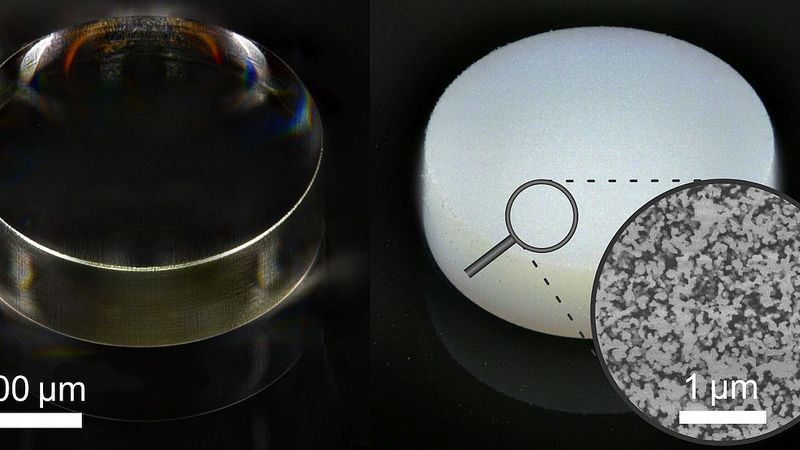A new type of photoresist enables 3D printing of the smallest porous structures
Researchers at the Karlsruhe Institute of Technology (KIT) and the University of Heidelberg have developed a photoresist for two-photon micro-printing with which, for the first time, three-dimensional polymer microstructures with cavities in nano-size can be produced.

Color change: The right micro-cylinder, printed with the new type of photoresist, appears white because the light is scattered in its spongy structure, while the cylinder printed from conventional photoresist appears transparent. (Fig .: 3DMM2O)
Researchers at the Karlsruhe Institute of Technology (KIT) and the University of Heidelberg have developed a photoresist for two-photon micro-printing with which, for the first time, three-dimensional polymer microstructures with cavities in nano-size can be produced. In the specialist journal Advanced Materials , the scientists of the joint excellence cluster 3D Matter Made to Order report how the porosity in the printing process can be controlled and how this affects the light scattering properties of the microstructures. (DOI: 10.1002 / adma.202002044)
Photoresists are printing inks that can be used to 3D print the smallest microstructures using so-called two-photon lithography. During printing, a laser beam is moved in all spatial directions through the initially liquid photoresist. Here the photoresist only hardens in the focal point of the laser beam. Gradually, complex microstructures can be built up in this way. In a second step, a solvent washes out those areas that have not been exposed. What remains are complex polymer architectures on a micro and nanometer scale.
Two-photon polymerization - or the two-photon micro-printing based on this process - has been intensively researched for several years - with regard to the production of micro-optics, so-called metamaterials or micro-scaffolds for experiments with individual biological cells. New printable materials are required to expand the range of applications. This is where the scientists of the Cluster of Excellence 3D Matter Made to Order (3DMM2O) at KIT and Heidelberg University come in: “With previous photoresists, it was only possible to print transparent, glass-like polymers,” explains Frederik Mayer, lead author of the study and physicist at KIT. “Our new photoresist makes it possible for the first time to print 3D microstructures from porous nano-foam.
From transparent to white
"Up to now there was no photoresist for 3D laser micro-printing that could be used to print 'white' material," says Frederik Mayer. Like in a porous egg shell, the numerous tiny air holes in the porous nano-architectures make them appear white. Simply mixing white particles into a conventional lacquer would not be a solution, because the photoresist has to be transparent to the (red) laser beam during printing. “Our lacquer,” says Mayer, “is transparent before printing, but the printed objects are white and therefore have a high degree of reflectivity.” The researchers from Karlsruhe and Heidelberg demonstrate this property by printing a hair-thin integrating sphere, a component the technical optics.
Another factor that opens up new possibilities is the extremely large internal surface area of the porous material. In filter processes in the smallest of spaces, in extremely water-repellent coatings or in the cultivation of biological cells, this could one day have a positive effect.
What the novel photoresist is suitable for and how it can be used in the best possible way could be described in an overarching collaboration of three of the nine main research areas of the Cluster of Excellence. Using electron microscopic scans and optical experiments, the researchers showed how the cavities are distributed in printed structures and how their formation can also be controlled by changing the pressure settings, especially the strength of the laser pulses. Heidelberg researchers in the field of materials science and Karlsruhe researchers in the fields of chemistry and physics have contributed to the current work in the Cluster of Excellence.
Cluster of Excellence 3D Matter Made to Order
In the Cluster of Excellence 3D Matter Made to Order (3DMM2O), scientists from the Karlsruhe Institute of Technology and Heidelberg University conduct interdisciplinary research into innovative technologies and materials for digitally scalable additive manufacturing processes in order to make 3D printing more precise, faster and more efficient. The aim is to completely digitize 3D manufacturing and material processing from the molecule to the macrostructure. In addition to funding as a cluster of excellence within the federal and state excellence strategy, 3DMM2O is funded by the Carl Zeiss Foundation.
Further information: www.3dmm2o.de
Original publication:
F. Mayer, D. Ryklin, I. Wacker, R. Curticean, M. Čalkovský, A. Niemeyer, Z. Dong, PA Levkin, D. Gerthsen, RR Schröder, M. Wegener: 3D Two ‐ Photon Microprinting of Nanoporous Architectures . Advanced Materials 2020, https://doi.org/10.1002/adma.202002044